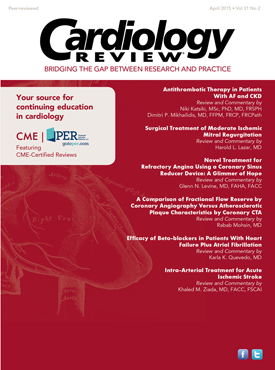Publication
Article
Cardiology Review® Online
CME Test - April 2015
Author(s):
Click here to review the CME questions for this month's issue.
CME Questions for Cardiology Review - April 2015
Angina
1. The results of the Coronary Sinus Reducer for Treatment of Refractory Angina (COSIRA) trial demonstrate all of the following except:
a. The Reducer coronary sinus device can be implanted relatively safely in patients with refractory angina.
b. Implantation of the Reducer device appears to lead to an improvement in CCS angina class when compared with a sham implantation procedure.
c. The mechanism of benefit of the Reducer device appears to be similar to that of the Vineberg procedure.
d. No statistically significant reductions in objective measures of ischemia were demonstrated in the COSIRA study
Interventional Cardiology
2. In patients with moderate ischemic mitral regurgitation undergoing coronary artery bypass graft (CABG) surgery, true statements regarding changes in left ventricular stroke work index (LVSWI) at 1 year include:
a. A combination of CABG plus mitral valve repair results in the most optimal reduction in LVSWI.
b. CABG alone results in a similar reduction in LVSWI compared with CABG plus mitral valve repair.
c. CABG plus mitral valve repair results in improved clinical outcomes and survival
compared with CABG alone.
d. None of the above.
Antithrombotic Therapy
3. In the study by Bonde et al the authors reported that:
a. patients on renal replacement therapy had a significantly higher risk of stroke/thromboembolism in all strata of the CHA2DS2-VASc score.
b. non-end-stage chronic kidney disease was independently related to a greater risk of stroke/ thromboembolism in patients with CHA2DS2-VASc = 0 or ≥ 2.
c. non-end-stage chronic kidney disease was independently related to a greater risk of stroke/ thromboembolism in patients with CHA2DS2-VASc = 1.
d. a and b
e. all the above
Heart Failure
4. The principal findings of the Kotecha et al. study were all of the following, EXCEPT:
a. Patients with heart failure and atrial fibrillation obtained little or no benefit from beta-blockers therapy.
b. The use of beta-blockers in patients with atrial fibrillation and heart failure has no significant reduction in all-cause mortality, CV hospitalization, or composite clinical outcomes compared with placebo.
c. The use of beta-blockers was associated with a 33% reduction in the adjusted odds of incident atrial fibrillation.
d. The use of beta-blocker therapy had an impact on incident nonfatal stroke in either sinus rhythm or atrial fibrillation.
e. Incident atrial fibrillation was more frequent in advanced age, male gender, obese people, and NYHA class III/IV at baseline.
Mohsin
Imaging
5. According to the study by Park et al, which of the following is the best predictor of ischemia in coronary plaque characterization?
a. positive remodeling
b. spotty calcification
c. luminal stenosis
d. aggregate plaque volume
Interventional Cardiology
6. In patients with acute ischemic stroke presenting within 4 hours of symptom onset, which of the following therapeutic strategies is associated with the best neurologic outcomes?
a. Endovascular therapy using retrievable stents with no need for thrombolysis
b. Endovascular therapy using retrievable stents only when thrombolysis fails
c. Thrombolysis followed by endovascular therapy in all patients with no evidence of hemorrhage
d. Thrombolysis and endovascular therapy in patients with large vessel occlusion and salvageable brain tissue.
